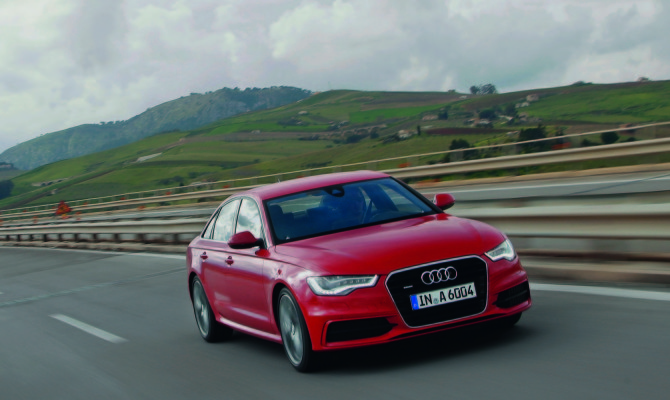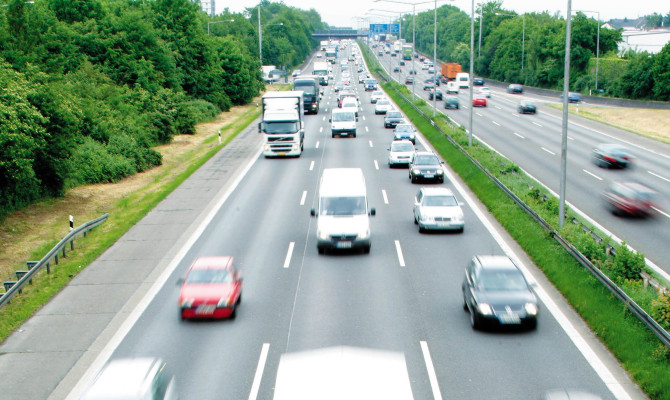I wound up the A6 to 200 km/h for less than a minute and shortly after I managed to hit 220 km/h but that lasted all of 20 seconds…
Much motoring mythology surrounds Germany’s speed limitless autobahns.
Many readers who favour an increase in posted limits on our freeways point to the superbly engineered German highways as the example to follow. The latest round of praise follows the recent Insights West poll conducted for Black Press that found 37 per cent back increased limits on routes such as the Coquihalla Highway. And doubtless BC Transportation Minister Todd Stone will hear the same in his review of highway speed limits during the eight regional public forums being held this month.
Hate to be a party pooper but today’s autobahns really don’t live up to their past reputation. They are excellent to drive but if you expect to cruise along at 250 km/h for the duration of a multi-hour journey you will be disappointed. In recent years, I’ve driven thousands of kilometres along high-speed freeways throughout Europe while attending launches for a variety of high-powered cars.
One of the most memorable trips I drove was the 585 kilometres between Munich and Berlin, which I covered in an Audi A6, with a 2.8-litre V6 generating 207 horsepower under the hood. Just like Vancouver, Munich is a thriving city and there’s congestion with a capital C even on the A9 autobahn. The queues continue even 30 kms outside of the city but it must be said that they move at a uniform speed of 100 km/h!
To say there are no speed limits is inaccurate: I encountered city areas where the maximum was 120 km/h overnight between 8 p.m. and 6 a.m. There are also restrictions in motorcycles, large trucks and cars towing trailers.
What I find most interesting was the unwritten rule, which, while it can’t be enforced, if you disobey it and are involved in a collision it may cost you. Say what? – The advisory speed limit under this “rule” is 130 km/h, referred to in German as the Richtgeschwindigkeit. Smash up at a higher speed and you could be found partially responsible due to “increased operating danger”.
Within an hour, I was comfortable with the car and itching to let it go. It seemed to be tugging to the right at one point but that was near the car’s birthplace at Ingolstadt. On the other hand, it could have been a crosswind.
You can only pass another car in the left lane. The right lane is for slower vehicles so you risk a ticket if you pass on the right at any speed. That threat didn’t seem to worry too many in the approaches to the various urban areas along the way.
As the traffic thinned, I wound up the A6 to 200 km/h for less than a minute and shortly after I managed to hit 220 km/h but that lasted all of 20 seconds. I managed to do 180 km/h for about three minutes before slowing to 140 for a sustained period of around 20 minutes. Europe is full and nowhere is that more evident than on the roads. I found 120 km/h was more easily achieved for most of the journey and seemed to be more typical a speed for most.
From Munich city limits to Berlin it took me around 5 hours 30 minutes, which means I averaged about 105 km/h. Pretty good but not the 200 km/h many think you can do.
There’s the reality check:
Generally, I agree that some of our freeways could stand a slight increase in the posted limit, especially in the rural areas where drivers would likely be able to maintain the top speed more easily than on the theoretically speed limitless autobahn.
Next week: The so-called Texas Autobahn.
Recent Comments
- { Enjoyed your Forest of Bowland in the BMW X5M, particularly the photo of the BMW in front of the main part of Stonyhurst College where... }
- { Bantam designed the Jeep, not Willy's or Ford. The American military gave the original Bantam prototype to Willys and Ford to copy. There is plenty... }
- { All Escalades come with a 6.2-lilter V8 engine that produces 420 horsepower. A six-speed automatic is the only transmission offered and drives the rear wheels.... }
- { Alexandra is an excellent journalist. }
Popular Posts
- Journey to a ‘Sparkling’ Luxury Okanagan Resort “Four lucky readers will put a Dodge Journey’s weekend-...
- The Need For Speed: Hike Those Highway Limits More than half of those polled believe the province sho...
- Drives-U-Crazy… Erratic drivers. An early morning drive from Kelowna to Vancouver is nor...
- Readers Respond: The Pros and Cons of Increasing B.C. Speed Limits Increasing the speed limits will only increase risk to...
- Honda CR-V Review: The Compact Crossover To Get Things Done The CRV is a very stylish and aerodynamic crossover veh...








